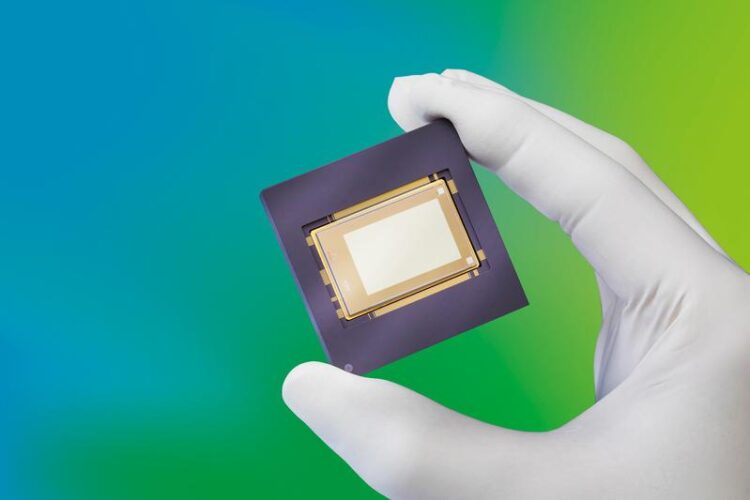From Microchips to Holograms – the Perfect Light Modulation

Micromirror array in ceramic package; 512x320 individually addressable mirrors with 48μm pixel size.
© Fraunhofer IPMS
Fraunhofer IPMS develops photonic microsystems that modulate light using small, controllable mirrors to create unique images and structures. These so-called spatial light modulators (SLM) are micromirror arrays with up to several million mirrors on a semiconductor chip. They have applications in semiconductor manufacturing, microscopy and holography, and have brought the Institute to the forefront of international research in this field.
In its own laboratories and the 1500 m² clean room, Fraunhofer Institute for Photonic Microsystems IPMS develops a wide variety of application-specific spatial light modulators based on 200 mm wafer technology. To enable individual deflection of each micromirror, a highly integrated electronic circuit (ASIC) is used as the basis for the component architecture. In combination with monolithically integrated MEMS (Micro Electro Mechanical Systems) technology, unique micromirror arrays are created.
In addition, Fraunhofer IPMS develops the electronics and software to drive the devices. To facilitate the technology transfer into application, the institute offers evaluation kits to its customers. The ready-for-trial setup includes not only the micro mirror chip itself but also the complete control electronics including software.
2-axis tilting mirror module of Fraunhofer IPMS; SLM chip with control electronics. © Fraunhofer IPMS
Fraunhofer IPMS spatial light modulators are used in deep ultraviolet microlithography, printed circuit board (PCB) manufacturing, semiconductor inspection and metrology, adaptive optics, astronomy, holography and microscopy. The ISO 9001 certification of the research institute underlines its quality, competence and performance.
High-performance 2-axis tilting mirrors from Fraunhofer IPMS
A groundbreaking development of the Dresden Research Institute is the technology platform of a CMOS-integrated micromirror array in which each mirror can be individually deflected via two tilting axes. The device consists of 512 x 320 individually addressable mirrors with a pixel size of 48 μm and enables the redirection of light beams or the generation and control of 2D intensity profiles and patterns with variable intensity. Because light is redistributed rather than masked, a high light yield is possible.
Piston micromirror arrays for 3D holography
A completely new field of application for the piston micromirrors of Fraunhofer IPMS is holography. In contrast to alternative methods such as stereo projection, holographic projection allows the virtual representation of objects with a 3D experience identical to that of real objects.
Micromirror arrays from Fraunhofer IPMS will enable computer-generated holography in the future. Real and virtual worlds merge – in motion and in real time. A mirror matrix optimized for holography is currently under development. The first application scenario is a head-up display (HUD) for automobiles.
At the Photonix exhibition in Japan from October 4 to 6, visitors can see the latest developments of Fraunhofer IPMS. A 2-axis tilting mirror demonstrator will be presented. In addition, the technology of spatial light modulators will be explained using macro models. The Fraunhofer IPMS booth is located at the Makuhari Messe (Chiba, Tokyo Area) in hall 8 booth #49-10. Appointments for expert talks with scientists and developers can be made in advance via the Fraunhofer IPMS website (https://www.ipms.fraunhofer.de/de/events/2023/Photonix.html).
About Fraunhofer IPMS
Fraunhofer Institute for Photonic Microsystems IPMS stands for applied research and development in the fields of intelligent industrial solutions and manufacturing, medical technology and health, and mobility. Research focuses on miniaturized sensors and actuators, integrated circuits, wireless and wired data communication and customized MEMS systems. Research and development takes place in two state-of-the-art clean rooms on 200 and 300 mm wafers. Services range from concept to process development and pilot production.
Media Contact
All latest news from the category: Power and Electrical Engineering
This topic covers issues related to energy generation, conversion, transportation and consumption and how the industry is addressing the challenge of energy efficiency in general.
innovations-report provides in-depth and informative reports and articles on subjects ranging from wind energy, fuel cell technology, solar energy, geothermal energy, petroleum, gas, nuclear engineering, alternative energy and energy efficiency to fusion, hydrogen and superconductor technologies.
Newest articles
Faster, more energy-efficient way to manufacture an industrially important chemical
Zirconium combined with silicon nitride enhances the conversion of propane — present in natural gas — needed to create in-demand plastic, polypropylene. Polypropylene is a common type of plastic found…

Energy planning in Ghana as a role model for the world
Improving the resilience of energy systems in the Global South. What criteria should we use to better plan for resilient energy systems? How do socio-economic, technical and climate change related…

Artificial blood vessels could improve heart bypass outcomes
Artificial blood vessels could improve heart bypass outcomes. 3D-printed blood vessels, which closely mimic the properties of human veins, could transform the treatment of cardiovascular diseases. Strong, flexible, gel-like tubes…





















